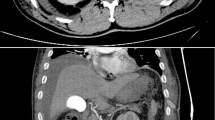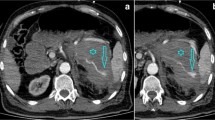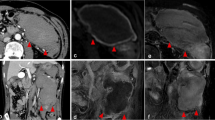Abstract
Abdominal wall hematoma is an uncommon cause of acute abdominal pain. We report a case of internal oblique hematoma caused by rupture of the subcostal artery in a 57-year-old woman. Ultrasonography (US) showed a hypoechoic mass in the right lateral abdominal wall. Contrast-enhanced computed tomography (CT) showed a large soft tissue mass with extravasation of contrast medium located in the right internal oblique muscle. Angiography showed contrast extravasation from the subcostal artery, and transcatheter arterial embolization was performed successfully.
Similar content being viewed by others
References
Manier JW. Rectus sheath hematoma: six case reports and a literature review. Am J Gastroenterol 1972;57:443–452.
Titone C, Lipsius M, Krakauer JS. Spontaneous hematoma of the rectus abdominis muscle: critical review of 50 cases with emphasis on early diagnosis and treatment. Surgery (St. Louis) 1972;72:568–572.
Lindbeck GH. Abdominal wall hematoma in an elderly man. Acad Emerg Med 1995;2:134–138.
William C, Lain D. Internal oblique hematoma: an alternative computed tomography diagnosis for flank pain. J Emerg Med 2001;21:183–184.
Chi-Ming T, Kao-Lang L, Chieh-Chang C. Lateral abdominal wall hematoma due to tear of internal abdominal oblique muscle in a patient under warfarin therapy. Am J Emerg Med 2005;23:911–912.
Zainea GG, Jordan F. Rectus sheath haematoma: their pathogenesis, diagnosis, and management. Am Surg 1988;54:630–633.
Linhares MM, LopesFilho GJ, Bruna PC, Ricca AB, Sato NY, Sacalabrini M. Spontaneous hematoma of the rectus abdominis sheath: a review of 177 cases with report of 7 personal cases. Int Surg 1999;84:251–257.
Casey RG, Mahmoud M, Carroll K, Hurley M. Rectus sheath haematoma: an unusual diagnosis. Ir Med J 2000;93:90–92.
Katsumari T, Nakajima K. A case of spontaneous hemorrhage of the abdominal wall caused by the rupture of a deep iliac circumflex artery treated by transcatheter arterial embolization. Eur Radiol 1998;8:550–552.
Tomoharu S, Kazuyoshi H, Toyokazu Y. Spontaneous hematoma of the lateral abdominal wall caused by a rupture of a deep circumflex iliac artery: report of two cases. Surg Today 2003;33:475–478.
Lohle PN, Puylaert JB, Coerkamp EG. Nonpalpable rectus sheath hematoma clinically masquerading as appendicitis: US and CT diagnosis. Abdom Imaging 1995;20:152–154.
Moreno Gallego A, Aguayo JL, Flores B. Ultrasonography and computed tomography reduce unnecessary surgery in abdominal rectus sheath haematoma. Br J Surg 1997;84: 1295–1297.
Çil BE, Türkbey B, Canyiğit M, Geyik S, Yavuz K. An unusual complication of carotid stenting: spontaneous rectus sheath hematoma and its endovascular management. Diagn Intervent Radiol 2007;13:46–48.
Juha-Matti I, Jukka M. Endovascular embolization of spontaneous retroperitoneal hemorrhage secondary to anticoagulant treatment. Cardiovasc Intervent Radiol 2004;27: 607–611.
Takeuchi K, Sakoguti T, Hidaka H. Skin ulcer after embolization of the arterio-venous fistula. Jpn J Phlebol 2005;16: 119–122.
Takahira N, Shindo M, Tanaka K. Gluteal muscle necrosis following transcatheter angiographic embolization for retroperitoneal haemorrhage associated with pelvic fracture. Injury 2001;32:27–32.
Suzuki T, Shindo M, Kataoka Y. Clinical characteristics of pelvic fracture patients with gluteal necrosis resulting from transcatheter arterial embolization. Arch Orthop Trauma Surg 2005;125:448–452.
Author information
Authors and Affiliations
Corresponding author
About this article
Cite this article
Nakayama, T., Ishibashi, T., Eguchi, D. et al. Spontaneous internal oblique hematoma successfully treated by transcatheter arterial embolization. Radiat Med 26, 446–449 (2008). https://doi.org/10.1007/s11604-008-0254-7
Received:
Accepted:
Published:
Issue Date:
DOI: https://doi.org/10.1007/s11604-008-0254-7




